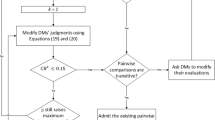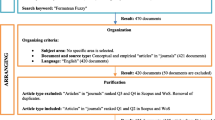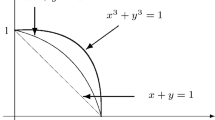Abstract
In this paper, we consider the factor of the decision maker’s risk preference, and define the left and right deviation degree respectively. Besides, we propose a new formula of the fuzzy degree. Then we get the multiattribute matrix of fuzzy numbers. We rank fuzzy numbers with the help of an ideal solution. Some numerical examples are displayed to illustrate the validity and advantages of the proposed ranking method.
Similar content being viewed by others
References
Yao J, Wu K (2000) Ranking fuzzy numbers based on decomposition principle and signed distance. Fuzzy Sets and Systems 116: 275–288
Chen L H, Lu H W (2001) An approximate approach for ranking fuzzy numbers based on left and right dominance. Computers and Mathematics with Applications 41: 1589–1602
Tran L, Duckein L (2002) Comparison of fuzzy numbers using a fuzzy distance measure. Fuzzy Sets and Systems 35: 331–341
Chu T, Tsao C (2002) Ranking fuzzy numbers with an area between the centroid point and original point. Computers and Mathematics with Applications 43: 11–117
Tsai C F, Asady B, Zendehnam A (2006) Ranking fuzzy numbers by distance minimization. Applied Mathematical Modelling 11: 2589–2598
Chen S (1985) Ranking fuzzy numbers with maximizing set and minimizing set. Fuzzy Sets and Systems 17: 113–129
Dubios D, Prade H (1978) Operations on fuzzy numbers. International Journal of Systems Science 9: 613–626
William V (1998) Some remarks on distances between fuzzy numbers. Fuzzy Sets and Systems 100: 353–365
Cheng C H, Mon D L (1993) Fuzzy system reliability by confidence interval. Fuzzy Sets and Systems 56: 29–35
Yong D, Zhu Z F (2006) Ranking fuzzy numbers with an area method using radius of gyration. Computers and Mathematics with Applications 51: 1127–1136
Yager R R (1981) A procedure for ordering fuzzy subsets of the unit interval. Information Science 24: 139–157
Wang Y M, Yang J B, Xu D L (2006) On the centroids of fuzzy numbers. Fuzzy Sets and Systems 157: 919–926
Baldwin J F, Guild N C F (1979) Comparison of fuzzy sets on the same decision space. Fuzzy Set and Systems 2: 213–231
Author information
Authors and Affiliations
Corresponding author
About this article
Cite this article
Wang, Zx., Mo, Yn. Ranking fuzzy numbers based on ideal solution. Fuzzy Inf. Eng. 2, 27–36 (2010). https://doi.org/10.1007/s12543-010-0035-8
Received:
Revised:
Accepted:
Published:
Issue Date:
DOI: https://doi.org/10.1007/s12543-010-0035-8




